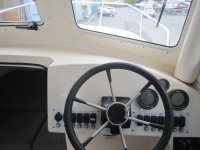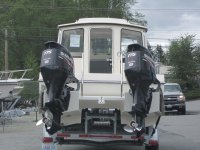To the specific question__I would probably increase the backing with an aluminum plate, and slightly longer bolts if necessary. The concern I have is that most likely this cleat bolts were just drilled thru the balsa cored deck--and no epoxy was used to line the hole, or undercut, of the deck, and thickened epoxy put there, to take the compression of the bolts. (some boats are built with plywood in the way of where cleats go--C Dory does not seem t have done this. The cleat can pull up against the fender washers and crush the core--it would take a signfificant load to do this, but if you have the time, in the long run, fixing the way that the bolts go thru the deck and a backing plate will serve you well in the long run.
I wonder what RPM the dealer got with the boat with only one person? My understanding is that the rated WOT is 6200 RPM and the Rev Limiter starts to tap in at 6350. I sure hope that the engine was well broken in before he reved her up to over 6300.
I suspect that your hard start/push the bulb could be one of two items---one could have been the boat had been run out of gas (It happend to me on my sea trial)--or the other the anti siphon valve. Since you got up to 6200 RpM--I suspect the former.
Now as to the prop--I wonder if you really want to go to the 23" pitch? I would want to know what you fuel consumption is at 15, 18, 22, 25 mph--these are speeds where you will be running the boat most of the time. I suspect that you will probably never again run the boat this light. I wouold personally stay with the 21.5" pitch. It is well proven and gives good economy.
As a calculate it you are getting 2.4 miles a gallon at 29 and 2.52 at 31 mph, which is excellent, and slightly better than most of us are getting (but we have much more weight aboard)
The closeness of the speeds and fuel flow--are not the best way to do a fuel curve--start with 4 mp, then 8 10 12 15 18 20 22 etc--and that will give you a better idea of where you will have the best economy. (I realize that this is just a sea trial)...What fuel flow system do you have? Another question is why the difference in the flow rates? almost half a gallon an hour in the one at 31. If it is a turbine transducer system, it might be calibration--if from the computer in the engine, they it should be accurate--and might reflect the counter rotation gear in the lower unit.
As for the cavitation plate--many of us have put on the Permatrim--it allows the bow to be pushed down and a better ride in heavier chop at lower speeds. Also a slightly better stern lift. My plate runs right on the top of the water.
Some moisture aft is normal. You can clean that up. As for moisture in the bilge elsewhere--I don't have any. BUT my boat sits on a lift, with the stern down by about 5 degrees, so if any water gets in, it all goes aft. I do get a little bilge water--not sure where it comes from--but I might have the bilge pump come on every few months or so--I have to suspect around the aft seat etc--but I do have a full camper canvas. The only other place might be around the engine tubings, or rub rail--and don't see any sign of that.
How are the rotation of the engines mounted? Most of the Cats are rt hand rotation on the port side and left hand rotation rt side. This gives more stern lift. It is also opposite of most boats. I find that this way of rigging gives better performance.
You should loose bite with the props only if you are getting near the trailering position (I assume that you have guages--if not you need them). I start with the engines, just below half down, then slowly bring them up until the RPM speeds up--and speed goes up. You will get the hang of it.
The boat does jump up on a plane--mine is still about 5 to 6 seconds from idle to 25. I am heavily loaded.
Congratulations--and good luck on getting all of these issues fixed. When they pull the foreward hatch frame, have the balsa core sealed with epoxy. I actually built a fiber glass rim around the cutout with epoxy, after undercutting it, and filling with epoxy and cabosil.


